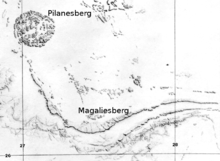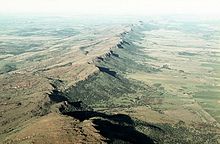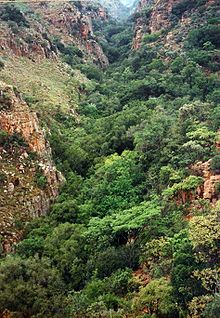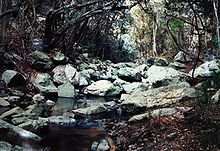- Magaliesberg
-
The Magaliesberg (historically also Cashan Mountains[1]) is a mountain range extending from Pretoria in the north of the Gauteng Province to a point south of Pilanesberg, in the North West Province, South Africa (see also Pilanesberg National Park). The highest point of the Magaliesberg is reached at Nooitgedacht (1 852 metres) 25°51′30″S 27°31′48″E / 25.8583°S 27.530°E.
Contents
Geology
The Magaliesberg Range has a very long geological history. Its quartzites, shales, chert and dolomite were deposited as sediments in an inland basin on top of the 3 billion year old Archaean Basement Complex. This process of sedimentation lasted for about 300 million years. About 2 billion years ago a massive upwelling of molten magma resulted in what is now known as the Bushveld Igneous Complex. The enormous weight of this intrusion depressed the sediments that lay beneath and tilted the sediments along the edges so that the broken scarps faced outward and upward, and the gentler dip slopes inward. During the same period these sediments were fractured and igneous intrusions of dolerite filled the cracks. With the passage of time these intrusions eroded, especially on the dip slopes, forming deep kloofs or ravines providing excellent rock-climbing potential to modern man. This large dogbone-shaped area is now termed the Transvaal Basin and includes the lofty escarpment of the Transvaal Drakensberg overlooking the Lowveld in the eastern part of the country. Massive outpourings of igneous material of the much younger Karroo System later covered the Transvaal Basin, but this was subsequently eroded so that it only remains along the Transvaal Basin's southern rim.
Climate
The range forms a natural barrier between the lower lying Bushveld to the north and the cooler Highveld to the south. The range receives rainfall in summer in the form of thunderstorms, with an average of 650 mm annually. In winter frost occurs frequently in the valleys on the southern side of the mountain, but almost never on the northern slopes.
History
The area around the Magaliesberg range has seen extremely lengthy occupation by humans dating back at least 2 million years to the earliest hominin species (such as Mrs Ples) in and around the Sterkfontein Caves, which lie at the Cradle of Humankind World Heritage Site, close to the town of Magaliesburg.
The later inhabitants of the mountain range called them the Kashan mountains, after a local chief. By the mid 1800s, one of the more important chiefs of the area was named, Mogale (or Mohale), and the mountains became known as Magaliesberg, or Mogale's mountain.[2] "Mogale" means "sharp" or "clever" person, but is also the common word for a warrior or Tswana soldier. Similarly, the mountain range to the north, near Sun City, Pilanesberg, was named after the local Bakghatla chiefs, who were called Pilane.[citation needed]
In 1822 Shaka sent his most trusted commander, Mzilikazi, to conquer the Sotho tribes of the region. After accomplishing this task, Mzilikazi decided to break away from Shaka and found his own nation, the Matabele. As he feared an attack from Shaka if he returned home he settled in the Magaliesberg regions.
On 17 January 1837, after some Voortrekkers had been attacked and killed by Mzilikazi's impis they counter-attacked and, under the leadership of Hendrik Potgieter and Gerrit Maritz, and with the help of local Sotho-Tswana chiefdoms, drove the Matabeles north across the Limpopo River. Because the re-conquest of the region was a cooperative venture of the Boers and the Sotho-Tswana against the Matabele, the Boers and Sotho-Tswana had friendly relations at the beginning of white settlement. These friendly relations are reflected in the name of the main Boer town, Rustenburg, or "resting town," because it seemed to them that they would not have to engage in any more fighting against African communities. The Boers initially settled south of the Magaliesberg in the highveld leaving the bushveld north of the Magaliesberg mostly to their Sotho-Tswana friends and allies; according to Ms. Sarah Heckford's memoir, "A Lady Trader in the Transvaal," the Boers would move into the bushveld to visit their Sotho-Tswana neighbors during the winter in what Heckford described as a big picnic. According to oral testimony by Tswana headmen recorded around the turn of the 20th century, many individual Boers formed close friendships with prominent individual Tswana headmen and chiefs, especially for the purpose of forming hunting parties to gather ivory and other products from further north. Subsequently the Boers began settling in the valleys of the Magaliesberg Range and in the bushveld north of the Magaliesberg, and turned the region into some of the most productive farmland in South Africa, while displacing their former allies, confining them to locations and reserves.
The area saw some heavy fighting during the Second Anglo-Boer War. The Boers, being extremely familiar with the mountains, used secret pathways across the mountains to launch guerrilla attacks on the British soldiers. In response, the British forces built blockhouses on top of the mountains in order to restrict the movement of the Boer forces; ruins of these structures are still to be seen on the mountain.
Control of the Magaliesberg Mountain Range was of great importance to both the Boer and the British forces, especially the two routes between Pretoria and Rustenburg, which crossed it at Silkaatsnek and Kommandonek, respectively. As a result many battles, such as the battles of Buffelspoort, Nooitgedacht and Olifantsnek were fought in the area.
After the war, farms in the area were reoccupied and farming was resumed, tobacco and citrus being particularly successful.
In 1923 the Hartbeespoort Dam, situated in one of the valleys of the range, was completed. It became a popular holiday and weekend destination for the inhabitants of Johannesburg and Pretoria, and the villages of Hartbeespoort and Kosmos developed as a result.
At present the Magaliesberg area is still largely agricultural, although tourism is a rapidly growing industry in the area.
Kgaswane Mountain Reserve is a nature reserve above Rustenburg covering 4257ha of the Magaliesberg. Numerous smaller reserves, private and state, are to be found along the length of the range.
Magaliesberg Biosphere Project
The Magaliesberg Biosphere Initiative Group (with beginnings in 2006) is active in trying to get the Magaliesberg proclaimed a Biosphere by UNESCO.[3]
The Magaliesberg was proclaimed a Protected Natural Environment in 1977 however the protection applies only to the core area.[4]
References
- ^ Stow, George William (1905). The native races of South Africa; a history of the intrusion of the Hottentots and Bantu into the hunting grounds of the Bushmen, the aborigines of the country. The Macmillan Co.. pp. 546. http://www.archive.org/stream/nativeracessout00stowgoog#page/n605/mode/1up/search/magalies.
- ^ Jenkins, Elwyn (2007), Falling into place: the story of modern South African place names, David Philip Publishers, p. 75
- ^ Magaliesberg Biosphere Initiative website - link extracted June 2010
- ^ Magaliesberg Biosphere Initiative website - link extracted June 2010
External links
Categories:- Mountain ranges of South Africa
- Climbing areas of South Africa
Wikimedia Foundation. 2010.




